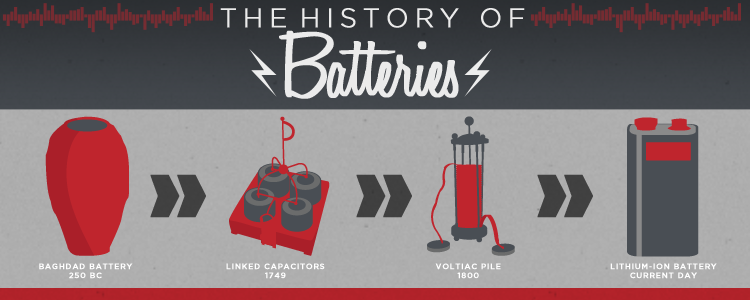History of Battery

The history of batteries is a fascinating journey that spans centuries. Here is a brief overview of key developments:
-
Ancient Batteries:
- Some archaeological findings suggest that simple batteries may have been used in ancient times. The Baghdad Battery, dated around 200 BCE to 224 CE, is a controversial artifact that some believe could have been a primitive battery.
-
Voltaic Pile (1800):
- The modern history of batteries began with Alessandro Volta in 1800 when he invented the voltaic pile. This early battery consisted of alternating layers of zinc, cardboard soaked in saltwater, and silver. It produced a continuous and stable electric current.
-
Daniell Cell (1836):
- John Frederic Daniell improved upon Volta's design with the Daniell cell. It used copper and zinc electrodes in separate compartments with a sulfuric acid solution. This design provided a more reliable and longer-lasting source of electrical power.
-
Grove Cell (1839):
- Sir William Robert Grove developed the Grove cell, another advancement in battery technology. It used a combination of zinc and platinum electrodes in sulfuric acid, producing a higher voltage than the Daniell cell.
-
Lead-Acid Battery (1859):
- Gaston Planté invented the lead-acid battery, which is considered the first rechargeable battery. This type of battery became widely used for various applications, including early electric vehicles.
-
Nickel-Cadmium Battery (1899):
- Waldemar Jungner patented the nickel-cadmium (NiCd) battery, another significant milestone. NiCd batteries offered a rechargeable alternative to lead-acid batteries and found applications in portable electronic devices.
-
Alkaline Battery (1950s):
- Lewis Urry developed the alkaline battery while working for the Eveready Battery Company. The alkaline battery had a longer life and higher energy density compared to previous designs.
-
Lithium Batteries (1970s):
- Lithium batteries were introduced in the 1970s, offering high energy density and a lightweight design. This technology has become the dominant choice for portable electronic devices and electric vehicles.
-
Lithium-Ion Batteries (1991):
- Sony commercialized the first lithium-ion battery in 1991. Lithium-ion batteries revolutionized portable electronics, providing a lightweight and rechargeable power source.
-
Advancements in Lithium Technology (2000s-2020s):
- Continued research has led to various advancements in lithium battery technology, including lithium-polymer batteries, solid-state batteries, and improvements in energy density and safety.
The history of batteries is marked by a series of innovations, each contributing to the development of more efficient and powerful energy storage solutions. Ongoing research and development continue to shape the future of battery technology.
Thank you.
